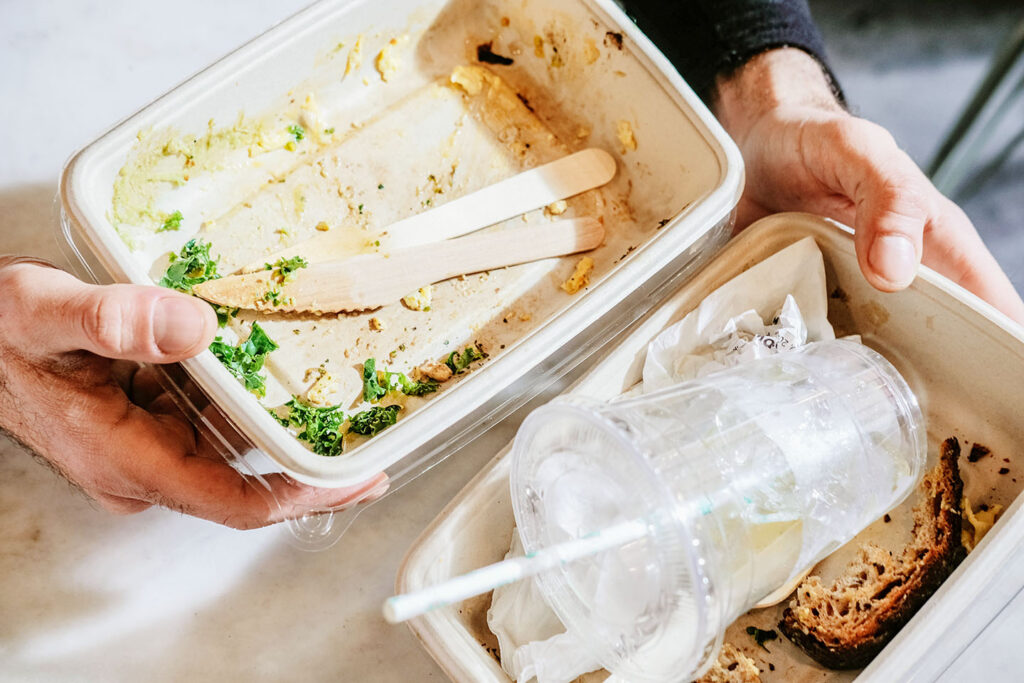Separate your Waste! Uncovering The New Recycling Reality for Households and Businesses
2023.12.15

Joakim Stattin is a biologist with roots in the tech industry. He holds a Master of Science in Business and Economics and is a project manager in the program area Sustainable Production & Consumption at Axfoundation.
Joakim Stattins Sustainability Insights: Hand on heart, do you empty the moldy jam jar before you throw it away? And what do you do if you find an old liver pâté whose expiration date passed around the time the Swedish men’s national football team last qualified for a championship? For many, the answer is probably to toss the container right into the trash or, perhaps, into the recycling bin. Unfortunately, neither of those options are particularly good since both glass and plastic can and should be recycled.
Most people probably understand that won’t happen if the jar ends up in the household garbage. Fewer may know that a container that hasn’t been emptied of its contents before reaching the recycling bin likely won’t be recycled. This, and many other problems related to packaging waste, is what the EU aims to address with the Green Deal, which has consequences for households as well as businesses.
Just like in my previous insight on single-use packaging, EU goals are driving changes in how we handle packaging. As of January 1, 2024, new rules on how packaging and bio-waste (read “food”) should be handled and collected will be in effect in Sweden. The engine behind these changes is the EU’s Green Deal, which in the Swedish context is expressed partly through the new so-called Packaging Regulation (2022:1274) and partly through changes in the Waste Regulation (2020:614) (in Swedish).
The EU goals aim to reduce the amount of packaging and packaging waste, while the waste that is produced should be reused and recycled to the greatest extent possible. This, in turn, is expected to lead to reduced littering and damage to the environment and health.
At the beginning of next year, it will no longer be allowed to discard leftover packaged goods as residual waste. Expired batches or goods that, for other reasons, cannot be sold or returned, must be carefully sorted from the turn of the year to facilitate recycling.

At the beginning of next year, it will no longer be allowed to discard surplus packaged goods as residual waste. Photo: iStock
Who is affected by the legislation?
The new legislation applies to both households and businesses. However, the transition required by a household is likely to be much smaller than the one awaiting many businesses. Take a grocery store, for example. At the beginning of next year, it will no longer be allowed to discard surplus packaged goods as residual waste. Expired batches or goods that, for other reasons, cannot be sold or returned, must be carefully sorted from the turn of the year to facilitate recycling.
Which materials are included?
According to the Packaging Regulation, the following should be sorted out from other waste:
- Paper and cardboard
- Plastic
- Metal
- Colored glass
- Clear glass
- Plastic bottles and metal cans that can be recycled
- Wood
- Material not covered in 1-7 (other packaging material)
What is not listed above but still constitutes a subcomponent in a product is classified as other waste. In a grocery store, that other waste will most likely consist of various food items that may no longer be sold.
Therefore, these foods must be separated from their packaging before the different types of waste can be sorted correctly. And since food is biobased, it is also subject to changes in the Waste Regulation (2020:614) regarding requirements for sorting and separate collection of bio-waste.
For a grocery store, this means in practice that every package of ham that can’t be sold must be emptied of its content so that the ham itself can become bio-waste, and the packaging can be recycled separately. This applies not only to deli meats but all packaging containing “bio-waste”, which should now be sorted out and collected separately. Oils and other edible fats are also subject to the requirements, but other liquid bio-waste such as coffee, tea, milk, and juice does not need to be separated from its packaging.
From next year, we can expect to see a much wider range of sorting options in public spaces than we are used to.
Good news for the environment
So, the requirements will bring significant changes to how grocery stores handle packaged food waste. At first glance, major changes are not always seen as good news from a business perspective. Nevertheless, with the right implementation, these changes can be very positive for the environment and climate. If large quantities of waste, previously considered residual, soon may be converted into biogas or recycled materials, that is, of course, very beneficial. It is however even better if the new requirements drive businesses to take more extensive measures to reduce waste in general, and packaged food waste in particular, even before the waste is generated.
It is also pleasing to note that the new rules from the packaging and waste regulations do not only apply to grocery stores. All businesses generating packaging waste are affected. Therefore, other types of stores, restaurants, and festivals, to name a few, also need to review their procedures for handling packaging waste. This means, for example, that restaurants and festivals must offer opportunities for their visitors to sort the waste generated during the visit. And even if the visitor fails to handle the waste correctly, the responsibility lies with the business operator.
Starting next year, we can, therefore, expect to see a much wider range of sorting options in public spaces than we are used to. And at home in the kitchens, perhaps some (at least the one behind these words) will scratch their heads and ponder if jam is classified as other liquid bio-waste or not…
/Joakim Stattin, Project Manager Sustainable Production & Consumption, Axfoundation






































